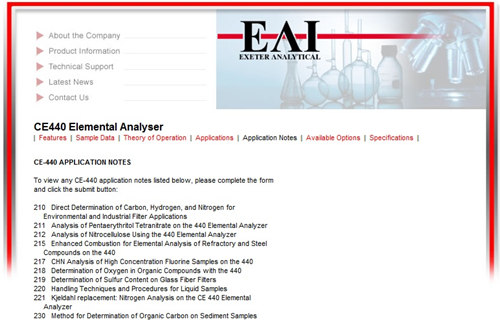Home > News > Exeter Analytical: CHN Determination of Highly Fluorinated Organic Compounds
Exeter Analytical: CHN Determination of Highly Fluorinated Organic Compounds
To accurately determine the percentage Carbon (C), Hydrogen (H) and Nitrogen (N) in highly fluorinated organic compounds**, Exeter Analytical Inc. has developed a reliable analytical method using their Model 440 Elemental Analyzer.
Generally compounds containing fluorine can be successfully analysed for percentage CHN content on most elemental microanalysis systems under standard operating conditions. The magnesium oxide in the combustion tube reagent packing absorbs fluorine as HF, and releases the hydrogen. However - highly fluorinated compounds, which are often difficult to combust, can give incorrect carbon and high nitrogen data. This is believed to be due to the strength of the C-F bond. If not fully oxidized, CF2 passes through the combustion tube packing and is detected as nitrogen, resulting in both low carbon and high nitrogen data.
Generally compounds containing fluorine can be successfully analysed for percentage CHN content on most elemental microanalysis systems under standard operating conditions. The magnesium oxide in the combustion tube reagent packing absorbs fluorine as HF, and releases the hydrogen. However - highly fluorinated compounds, which are often difficult to combust, can give incorrect carbon and high nitrogen data. This is believed to be due to the strength of the C-F bond. If not fully oxidized, CF2 passes through the combustion tube packing and is detected as nitrogen, resulting in both low carbon and high nitrogen data.
For these highly fluorinated compounds, Exeter Analytical have developed a new reliable analytical method based upon their Model 440 Elemental Analyzer that is described in Application Note 217.
For a copy of application note 217 please visit www.exeteranalytical.co.uk/ce440_notes.htm or contact Exeter Analytical on +1-978-251-1411 / +44-2476-323223 or email sales@eai1.com / info@exeteranalytical.co.uk
Benefiting from a horizontal furnace design, the Exeter Analytical Model 440, allows analysts to routinely produce accurate and precise data on wide ranging sample types without system re-optimisation, saving precious time and reducing running costs.
Exeter Analytical is a company dedicated to elemental analysis. Through many years of continuous investment in applications development and valuable customer feedback, the Exeter Model 440 CHN Elemental Analyzer, with its unique horizontal furnace design, is widely viewed to be the most accurate and precise analyzers available on the market today, with the broadest range of sample applications.
** Highly fluorinated organic compounds are often extremely thermally and chemically stable and have soil, water and fat-repellent properties. They are nearly non-biodegradable and accumulate in the environment and the food chain. Due to their specific technical characteristics – highly fluorinated compounds are used in quite a number of products such as in textiles, carpets, cosmetics, paper, packaging materials as well as in general in the chemical synthesis, metallation, photo and semi-conductor industries.
For a copy of application note 217 please visit www.exeteranalytical.co.uk/ce440_notes.htm or contact Exeter Analytical on +1-978-251-1411 / +44-2476-323223 or email sales@eai1.com / info@exeteranalytical.co.uk
Benefiting from a horizontal furnace design, the Exeter Analytical Model 440, allows analysts to routinely produce accurate and precise data on wide ranging sample types without system re-optimisation, saving precious time and reducing running costs.
Exeter Analytical is a company dedicated to elemental analysis. Through many years of continuous investment in applications development and valuable customer feedback, the Exeter Model 440 CHN Elemental Analyzer, with its unique horizontal furnace design, is widely viewed to be the most accurate and precise analyzers available on the market today, with the broadest range of sample applications.
** Highly fluorinated organic compounds are often extremely thermally and chemically stable and have soil, water and fat-repellent properties. They are nearly non-biodegradable and accumulate in the environment and the food chain. Due to their specific technical characteristics – highly fluorinated compounds are used in quite a number of products such as in textiles, carpets, cosmetics, paper, packaging materials as well as in general in the chemical synthesis, metallation, photo and semi-conductor industries.
-----------
Worldwide HQ
Exeter Analytical Inc
Chelmsford, MA USA
tel. +1-978-251-1411
fax +1-978-251-4536
Email sales@eai1.com
European HQ
Exeter Analytical (UK) Ltd.
Exeter Analytical (UK) Ltd.
University of Warwick Science Park
Barclays Venture Centre
Sir William Lyons Road
Coventry CV4 7 EZ
UK
tel. +44-2476-323223
fax +44-2476-323221
Related News
- High Specification Optical Flats for Custom Fizeau Interferometer 12/18/2025
- Merck Launches ChemiSphere® App to Simplify Digital Data Access and Boost L 12/17/2025
- Breathing New Life into Older High-speed Cameras 12/16/2025
- Cold Chain Technologies Expands Industry-Leading Reusable Portfolio 12/11/2025
- Sabin Vaccine Institute’s Investigational Marburg Vaccine Delivered to Ethiopia 12/9/2025
- Cutting-edge Product for Stem Cell Research and Human Embryo Modelling 12/4/2025
- Thermo Fisher Scientific Launches Industry-First, Multi-Parameter Molecular Assa 11/20/2025
- Biotech Fluidics: Solvent Recyclers Improve HPLC System Sustainability 11/20/2025
- Titan Enterprises’ Beverage Flow Meters: Turbine vs. Ultrasonic – Which is Right 11/19/2025
- Gentle and Rapid Detachment of Even Delicate Adherent Cells 11/18/2025



